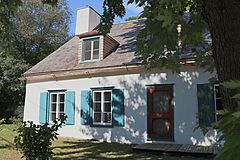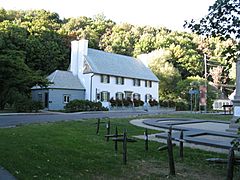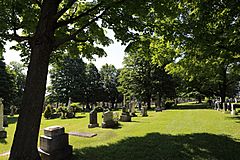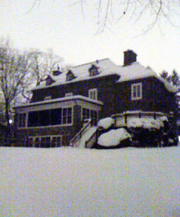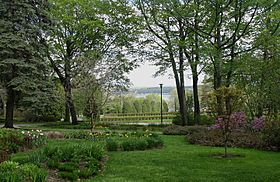Sillery Heritage Site facts for kids
Quick facts for kids Sillery Heritage Site |
|
|---|---|
| Native name French: Site patrimonial de Sillery |
|
| Arrondissement historique de Sillery | |
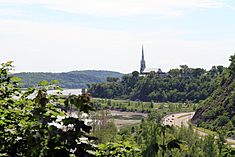
View of Saint-Michel de Sillery Church
|
|
| Type | Heritage District |
| Etymology | Noël Brûlart de Sillery |
| Location |
|
| Settled | 1637 |
| Founder |
|
| Built for | |
| Original use | Saint-Joseph Mission of Sillery — Jesuit mission to members of the First Nations |
| Governing body |
|
| Official name: Site patrimonial de Sillery | |
| Type | Patrimoine immobilier (Heritage immovable property) |
| Designated | 5 February 1964 |
| Reference no. | 93522 |
| Former name | Arrondissement historique de Sillery |
| Recognition statute | Loi sur les biens culturels (Cultural Property Act) |
The Sillery Heritage Site (French: site patrimonial de Sillery), formerly known as the Sillery Historic District (French: arrondissement historique de Sillery), is a territory containing historic residential and institutional properties, as well as woodlands, located in the Sainte-Foy–Sillery–Cap-Rouge borough of Quebec City, Quebec, Canada. It is one of four heritage sites which are located in the City of Quebec. Having been called the "cradle of the Quebec nation," it includes approximately 350 buildings situated on a linear 3.5 kilometres (2.175 miles) wide landscape, which is alongside, as well as an integral part of the coast of the Saint Lawrence River. The built environment was constructed in all of the time periods, including and following the foundation of New France (French: Nouvelle-France).
Amongst the district's properties are the early 18th century Jesuit House of Sillery (French: maison des Jésuites-de-Sillery), 19th century workers' homes on Foulon Road (French: chemin du Foulon (also known during this time period by the English name Cove Road)) and the Sillery coast (near Saint-Michel of Sillery Church (French: église Saint-Michel de Sillery), villas built by wood barons in the 19th century, and institutional properties built at the turn of the 20th century.
Heritage designation began as early as 1929, when the Jesuit House was assigned protective status. The entire territory was officially recognized as a heritage site by the Government of Quebec (French: Gouvernement du Québec) on 5 February 1964. The heritage site was placed on the Parks Canada's administered Canadian Register of Historic Places (CRHP; (French: Répertoire canadien des lieux patrimoniaux), also known as Canada's Historic Places, on 22 June 2006. The site's provincial heritage registry listing includes five categorical groups of associated elements: 627 heritage immovable / real property assets, nine associated movable heritage objects, 18 related commemorative plaques, two associated groups, and three associated people.
While recognizing the visionary action taken by Quebec's Ministry of Culture (French: ministère de la Culture), in the 1960s, by conferring historic status upon the district to protect it from suburban developers, the National Trust for Canada (French: Fiducie nationale du Canada), a registered charity, placed the Sillery Historic District on its Top 10 Endangered Places list (French: Palmarès des 10 sites les plus menacés), in the early 2010s, due to the approval of condominium developments which encroached upon historic religious properties in the district. In 2015, the City of Quebec announced that it would encourage any future developers to restore historic religious structures which were no longer owned by their former communities, in exchange for the allowance to undertake development on the surrounding lands. The city argued that some development was necessary to provide tax revenue in order to sustain the preservation of the historic district. The Trust has subsequently removed the Sillery Historic District from its endangered list, and archived its status as a past listing, amongst other properties, spread across all of Canada's provinces and territories.
Historic properties located on the heritage site
Partial List of Properties
| Name | Address | Coordinates (links to map & photo sources) |
Name | |
|---|---|---|---|---|
| George William Usborne House. Canadian Register of Historic Places. |
|
46°46′04″N 71°15′28″W / 46.7678°N 71.25773°W | French: maison George-William-Usborne | |
| Jesuit House of Sillery. Canadian Register of Historic Places. |
|
46°46′07″N 71°15′29″W / 46.768523°N 71.258053°W | French: maison des Jésuites-de-Sillery | |
| Villa Bagatelle (Spencer Cottage) |
|
46°47′18″N 71°14′48″W / 46.788278°N 71.24675°W | ||
| Saint-Patrick Cemetery |
|
46°47′08″N 71°14′47″W / 46.78547°N 71.2465°W | French: cimetière Saint-Patrick | |
| Mount Hermon Cemetery |
|
46°46′51″N 71°14′50″W / 46.78085°N 71.247197°W | French: cimetière Mount Hermon | |
| Cataraqui Estate. Canadian Register of Historic Places. |
|
46°46′23″N 71°15′11″W / 46.77311°N 71.25319°W | French: domaine Cataraqui | |
| Villa Beauvoir |
|
46°46′11″N 71°15′39″W / 46.769843°N 71.26086°W | ||
| Kilmarnock Manor, residence of John MacNider |
|
46°46′04″N 71°15′52″W / 46.767678°N 71.264512°W | French: manoir Kilmarnock | |
| Bois-de-Coulonge Park (Spencer Wood / Government House) |
|
46°47′20″N 71°14′24″W / 46.788889°N 71.24°W | French: parc du Bois-de-Coulonge | |
| Saint-Michel de Sillery Church |

|
46°46′28″N 71°14′39″W / 46.774334°N 71.244144°W | French: église Saint-Michel de Sillery |
- Canadian Montmartre and Sanctuary of the Sacred Heart (French: Montmartre Canadien et Sanctuaire du Sacré-Cœur), 1669, chemin Saint-Louis
- Villa Clermont, 2211, chemin Saint-Louis
- Bignell House (French: maison Bignell), 1524, côte à Gignac
- Timmony House (French: maison Timmony), 2014, rue Louis-H. Lafontaine
Related articles



